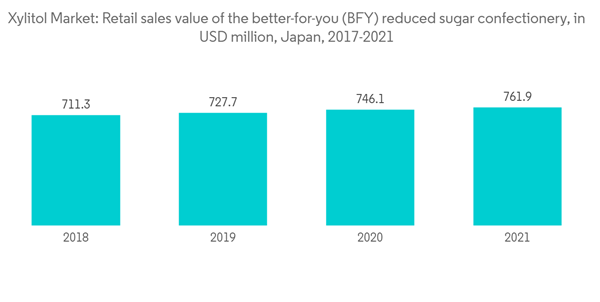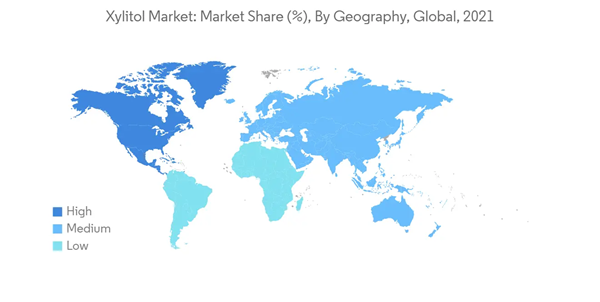The Xylitol Market size is estimated at USD 1.06 billion in 2024, and is expected to reach USD 1.37 billion by 2029, growing at a CAGR of 5.11% during the forecast period (2024-2029).
Xylitol is widely approved for use in food around the world. It is also extensively approved for oral hygiene products, pharmaceuticals, cosmetics, and toiletries. The increasing demand for natural sweeteners in chewing gums drives the Xylitol market. Xylitol-based chewing gums reportedly offer various dental benefits, such as helping prevent tooth decay and dry mouth and helping boost oral health. Growing demand for xylitol in food and nutraceutical applications is expected to be a key driving factor for the market over the forecast period. Low-calorie, crystalline xylitol is a natural sweetener found in fibrous plant foods and hardwood trees. It is the only sugar that has the same sweetness intensity as compared to sucrose. It can be produced by chemical or enzymatic hydrolysis from different plant sources having polysaccharides. It is largely produced through a chemical process at an industrial scale, which is based upon catalytic xylose dehydrogenation. The process is not only cost and energy-intensive but also environmentally risky due to the use of a toxic catalyst and high-pressure hydrogen gas.
Food goods' color, flavor, and shelf life are also improved. Xylitol-containing chewing gum is well known for its medicinal benefits. Cough syrups, tonics, and vitamin preparations become nonfermentable when Xylitol is added. Due to its non-cariogenic and nonfermentable qualities, it is included in diets as a healthy supplement for diabetic patients.Further, the xylitol market is driven by the increase in its consumption in food and personal care applications. Also, the growth driver for xylitol (as for other low-calorie sweeteners), is the increasing number of diabetes people around the world.
According to the International Diabetes Federation, China will have the largest diabetic population in 2021, with 140.9 million people affected. Some of the benefits of reducing sugar intake include helping with weight loss and preventing obesity, lowering the risk of type 2 diabetes or pre-diabetes, and reducing the risk of inflammatory digestive conditions such as irritable bowel disease and Crohn's disease. According to Agriculture and Agri-Food Canada, the retail sales value of better-for-you and reduced-sugar confectioneries sold in Japan amounted to approximately 762 million dollars in 2021.
Moreover, the rising prevalence of heart attacks, obesity, and the diabetic population in the country has resulted in people shifting towards a sugar-free lifestyle. As per the National Institute of Statistics and Geography, heart conditions were the most common cause of death after COVID-19 in Mexico, with nearly 114 thousand deaths registered during the first six months of 2021. The United States-based global suppliers use wood as feedstock for the production of commercial xylitol. Xylitol has also been extensively approved for oral hygiene products, pharmaceuticals, cosmetics, and toiletries.
The players in the industry are actively involved in mergers and acquisitions. Companies compete on different factors, including other ingredient-based product offerings, quality, and their ability to scale to gain a competitive advantage in the market. In addition, these key players are also now focusing on expanding their production facilities to cater to the additional demand that arises along with the growth in the market.
This product will be delivered within 2 business days.
Xylitol is widely approved for use in food around the world. It is also extensively approved for oral hygiene products, pharmaceuticals, cosmetics, and toiletries. The increasing demand for natural sweeteners in chewing gums drives the Xylitol market. Xylitol-based chewing gums reportedly offer various dental benefits, such as helping prevent tooth decay and dry mouth and helping boost oral health. Growing demand for xylitol in food and nutraceutical applications is expected to be a key driving factor for the market over the forecast period. Low-calorie, crystalline xylitol is a natural sweetener found in fibrous plant foods and hardwood trees. It is the only sugar that has the same sweetness intensity as compared to sucrose. It can be produced by chemical or enzymatic hydrolysis from different plant sources having polysaccharides. It is largely produced through a chemical process at an industrial scale, which is based upon catalytic xylose dehydrogenation. The process is not only cost and energy-intensive but also environmentally risky due to the use of a toxic catalyst and high-pressure hydrogen gas.
Food goods' color, flavor, and shelf life are also improved. Xylitol-containing chewing gum is well known for its medicinal benefits. Cough syrups, tonics, and vitamin preparations become nonfermentable when Xylitol is added. Due to its non-cariogenic and nonfermentable qualities, it is included in diets as a healthy supplement for diabetic patients.Further, the xylitol market is driven by the increase in its consumption in food and personal care applications. Also, the growth driver for xylitol (as for other low-calorie sweeteners), is the increasing number of diabetes people around the world.
Xylitol Market Trends
Rising Demand For Sugar Free Products
Rising concern about sugar intake has led to the collapse of sugared chewing gum consumption. The rising demand for sugar-free chewing gum and confectionery in developed and developing markets drives the market for non-calorie sweeteners like xylitol. Hence, it is a common ingredient in sugar-free chewing gum, candies, mints, diabetes-friendly foods, and oral-care products. The major chewing gum brands in the United States, like Trident, Orbit, Extra, Dentyne 5, and Eclipse, specialize in sugar-free, mint-flavored gum.According to the International Diabetes Federation, China will have the largest diabetic population in 2021, with 140.9 million people affected. Some of the benefits of reducing sugar intake include helping with weight loss and preventing obesity, lowering the risk of type 2 diabetes or pre-diabetes, and reducing the risk of inflammatory digestive conditions such as irritable bowel disease and Crohn's disease. According to Agriculture and Agri-Food Canada, the retail sales value of better-for-you and reduced-sugar confectioneries sold in Japan amounted to approximately 762 million dollars in 2021.
North America Holds a Prominent Share in The Market
The United States is one of the largest consumers of xylitol on the global market. The demand is high due to multiple health benefits, like low calorific value, tooth decay-defying properties, and low carbohydrate content. This has encouraged its application among health-conscious consumers in the United States. The United States Food and Drug Administration (US FDA) has approved the use of xylitol in foods for particular dietary purposes as a direct food additive, which further extends to all the other sugar-free and no-sugar-added products and has classified it as "generally recognized as safe" (GRAS).Moreover, the rising prevalence of heart attacks, obesity, and the diabetic population in the country has resulted in people shifting towards a sugar-free lifestyle. As per the National Institute of Statistics and Geography, heart conditions were the most common cause of death after COVID-19 in Mexico, with nearly 114 thousand deaths registered during the first six months of 2021. The United States-based global suppliers use wood as feedstock for the production of commercial xylitol. Xylitol has also been extensively approved for oral hygiene products, pharmaceuticals, cosmetics, and toiletries.
Xylitol Industry Overview
The Xylitol market is highly competitive, with key players such as Cargill, Incorporated; Ingredion, Inc.; Zhejiang Huakang Pharmaceutical Co., Ltd.; Roquette Freres; and Archer Daniels Midland Company.The players in the industry are actively involved in mergers and acquisitions. Companies compete on different factors, including other ingredient-based product offerings, quality, and their ability to scale to gain a competitive advantage in the market. In addition, these key players are also now focusing on expanding their production facilities to cater to the additional demand that arises along with the growth in the market.
Additional Benefits:
- The market estimate (ME) sheet in Excel format
- 3 months of analyst support
This product will be delivered within 2 business days.
Table of Contents
1 INTRODUCTION
4 MARKET DYNAMICS
5 MARKET SEGMENTATION
6 COMPETITIVE LANDSCAPE
Companies Mentioned (Partial List)
A selection of companies mentioned in this report includes, but is not limited to:
- Cargill, Incorporated
- Thomson Biotech (Xiamen) Co., Ltd.
- Archer Daniels Midland Company
- Ingredion Incorporated
- Zhejiang Huakang Pharmaceutical Co., Ltd.
- Nova Green Inc.
- Roquette Freres
- DuPont de Nemours, Inc.
- Merck KGaA
- Avanschem
Methodology

LOADING...










